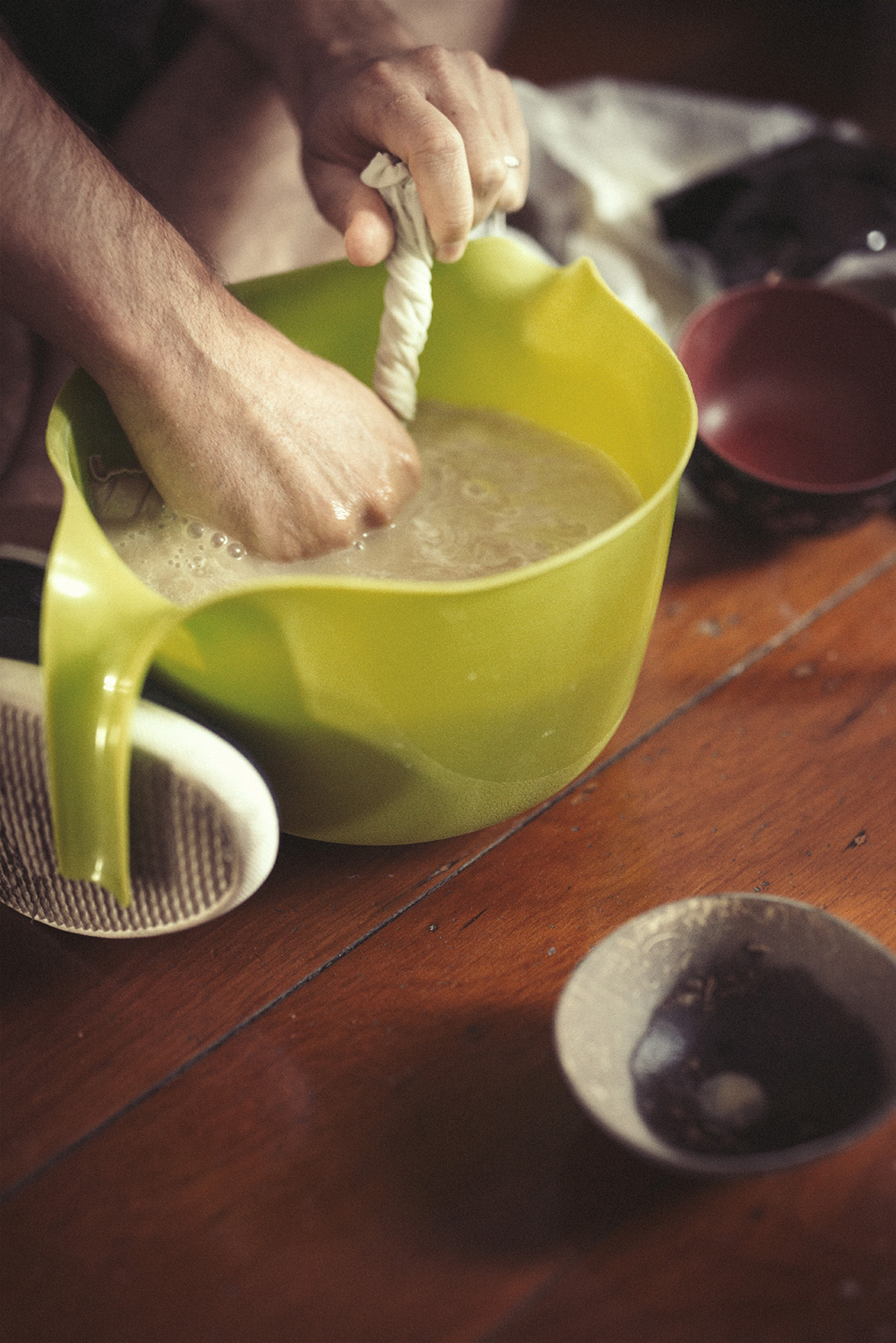Preparation & Storage
According to current European regulations, our premium kavas are intended for non-traditional applications – primarily as natural textile dyes and in aromatherapy. The preparation process is simple and based on traditional methods used across the Pacific islands, where kava has been used for thousands of years.
Traditional Grind Preparation
The classic method takes about 10 minutes and produces a rich, creamy liquid with characteristic golden-brown colours that vary by cultivar.
What you’ll need:
- 35-40g traditional powder (about 1/3 cup)
- Strainer bag (essential for filtering fibres)
- 500-600ml water at room temperature or slightly warm
The process:
- Place powder in your strainer bag and submerge in water
- Knead firmly for 5-10 minutes – this mechanical action extracts the natural pigments
- Squeeze out all liquid from the bag
- The resulting liquid should have a creamy, opaque appearance
Alternative blender method: Blend 35g powder with cold water for 2-3 minutes, then strain through bag. Faster but may produce a slightly different texture.
Note: Blending with sharp blades for too long can chop fibres very fine, allowing them to pass through the strainer. These fibres are not harmful but may affect the liquid’s texture.
Second Wash
You can add fresh water (half the original amount) to the used grounds in the bag for a weaker second extraction. Research shows the first wash extracts about 50% of available pigments, the second adds another 15%. You can combine both batches or use them separately.
Instant Kava Preparation
Our instant kava is dehydrated juice, not ground root, making preparation remarkably simple.
What you’ll need:
- 8g instant powder (1-2 teaspoons)
- 200ml water or juice
Simply stir thoroughly – no straining required. The powder creates a smooth suspension without fibres or sediment.
Preparation Tips
Water temperature: Room temperature to body temperature works best. Never use hot water as it can affect the delicate pigments.
Ratios: The standard is 1:15 (1g kava to 15ml water) but adjust to the colour intensity you need. Stronger preparations use less water, lighter ones use more.
Working with Textiles
Both traditional and instant kava produce liquids with distinctive natural colours – from pale gold through caramel to deep chocolate brown, depending on the cultivar. These organic pigments make kava particularly interesting for textile and artistic applications.
For working with fabrics, both forms perform well. Instant dissolves cleanly without residue, making it convenient for precise colour work. Traditional grind, with its fuller texture and suspended particles, can create more complex, layered tones on natural fibres.
To dye textiles: soak fabric in prepared liquid for several hours or overnight, then hang to dry. Always wash dyed items in cold water to preserve colour.
Aromatherapy Applications
Kava’s natural, nutty aromas make it suitable for aromatic applications:
- Straight from the package: Dry powder can be smelled directly – fresh, high-quality kava has a pleasant, nutty aroma
- Scent sachets: Soak fabric in prepared liquid, allow to dry completely, and place in wardrobes or drawers
- Traditional method: During traditional preparation (kneading in bag), natural aromas are released intensely
Aroma intensity varies by cultivar and preparation strength.
Storage Guidelines
Proper storage preserves the fresh characteristics that distinguish quality kava:
Before opening: See best before date on packaging.
Once opened: Store in an airtight container in a dry, cool, dark place. Avoid any moisture – even small amounts can cause degradation. Use within 12-18 months.
Quality You Can Trust
Every batch from the Kava Society comes with:
- Single cultivars from regions optimal for each variety
- Harvested to order – never old village stock
- Meticulously peeled and washed roots
- Temperature-controlled drying within hours
- Vacuum-sealed or nitrogen-flushed packaging
- UHPLC laboratory analysis (superior to standard HPLC)
The difference is visible immediately – fresh, vibrant colours and clean, fresh aromas that indicate extreme purity and proper processing.
For detailed information about different kava forms and their characteristics, see our Traditional vs Instant guide. For specific cultivar profiles and their unique properties, explore our product range.



